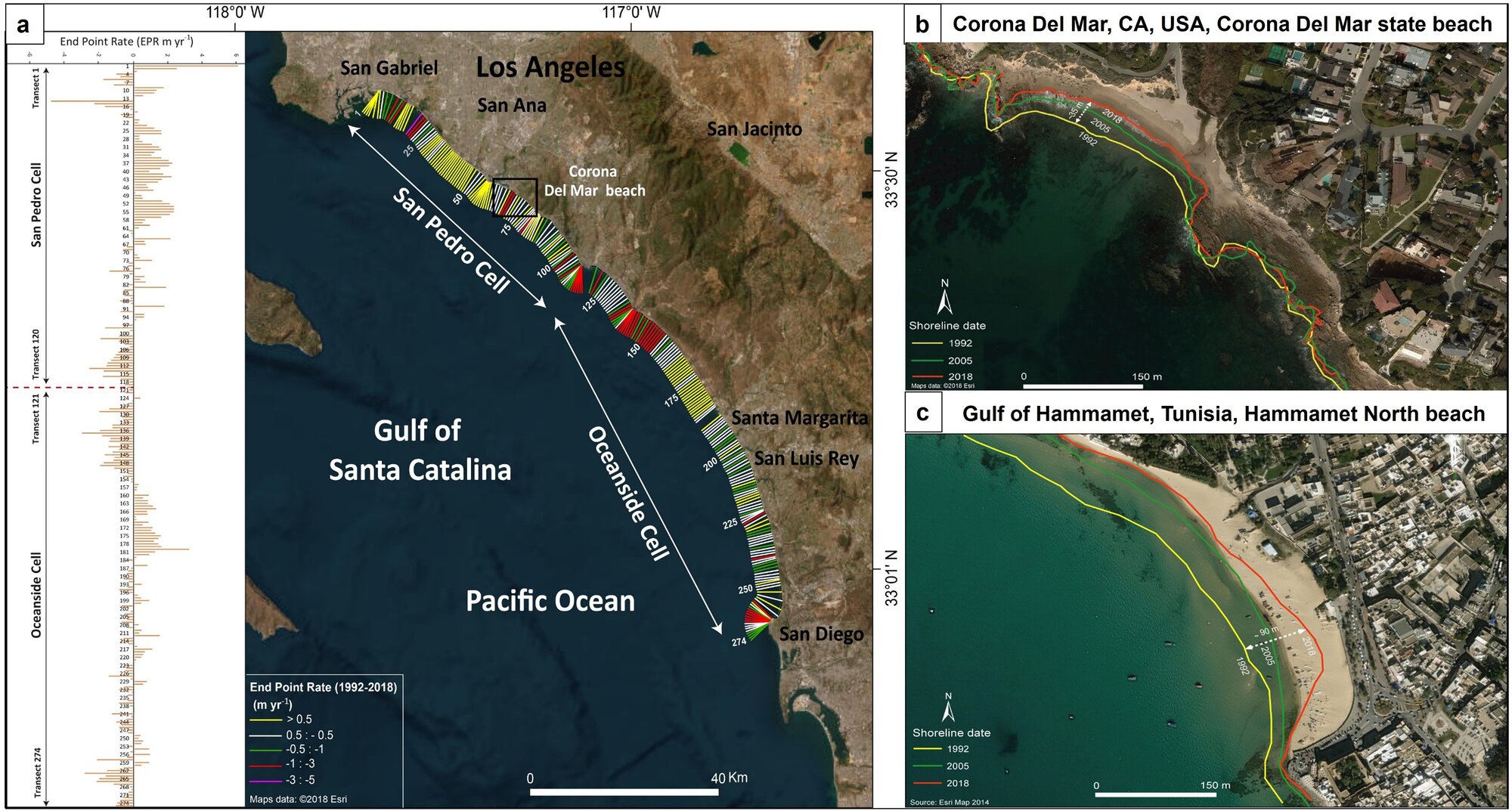California
Beach erosion will make Southern California coastal living five times more expensive by 2050, study predicts

Rising sea levels and urban development are accelerating coastal erosion at an alarming rate in Southern California with significant ripple effects on the region’s economy, a USC study reveals.
The study, published in Communications Earth & Environment, predicts that Southern California’s coastal living costs will surge fivefold by 2050 as a direct result of beach erosion. This erosion will require more frequent and costly beach nourishment projects to maintain the state’s treasured shorelines, consequently driving up the cost of living along the coast.
“Our study presents compelling evidence of the rapid deterioration of Southern California’s coastal landscapes,” said Essam Heggy, a geoscientist in the Ming Hsieh Department of Electrical and Computer Engineering/Electrophysics at the USC Viterbi School of Engineering and the study’s corresponding author.
“The challenges facing Southern California mirror a growing threat shared by coastal communities worldwide. The environmental and economic implications of coastal erosion reach far beyond California’s shores and demand interdisciplinary, global solutions,” he said.
Coastal erosion: Cost of living sure to surge as sandy beaches disappear
To predict future changes along California’s sandy coastlines, the researchers focused on the Gulf of Santa Catalina, which stretches over 150 miles from the Palos Verdes Peninsula in Los Angeles County to the northern tip of Baja California in Mexico.
They used a combination of historical and recent satellite images as well as advanced algorithms to analyze coastline movement and predict future erosion based on different trends and environmental factors.
The study predicts a tripling of erosion rates by 2050, increasing from an average of 1.45 meters per year to 3.18 meters by 2100. Consequently, the annual sand requirement for beach nourishment could triple by 2050, with costs rising fivefold due to the global increase in sand prices. This will exacerbate economic and logistical pressures on coastal communities.
Beach nourishment is adding sand to an eroded beach to rebuild it and create a wider barrier against waves and storms.
“Our investigation suggests that coastal problems start inland due to the rapid growth of cities along the coast, which compromise inland sediment replenishment of sandy beaches,” said Heggy, whose research focuses on understanding water evolution in Earth’s arid environments.
“As our beaches shrink, the cost of maintaining them will rise. Finding innovative solutions is key to securing a sustainable future for our shores and local economies,” he said.
Coastal erosion in California: A case study for a global problem
Coastal cities in Southern California and those in North Africa bordering the Mediterranean Sea face a common challenge: a semi-arid climate year-round coupled with the growing threats of rising sea levels and eroding shorelines.
A significant portion of Earth’s landmass, roughly 41%, falls under arid or semi-arid classifications, and these areas support over a third of the global population.
To understand this global challenge, the researchers focused on two specific locations: Corona del Mar in Orange County, Calif.—an example of the typical Southern California coastline—and Hammamet North Beach in Tunisia. Both are densely populated and share similar climates, prone to increasing droughts, flash floods and unpredictable rainfall patterns. These characteristics mirror the challenges faced by countless coastal communities worldwide.
The findings showed that the average rate of shoreline retreat in these areas varies. In Southern California, beaches are receding between 0.75 and 1.24 meters per year. In Hammamet North Beach, the retreat rate ranges from 0.21 to about 4.49 meters annually.
“While beach nourishment can temporarily combat erosion, however, it presents significant challenges for developing countries,” said Oula Amrouni, a sedimentologist at the National Institute of Marine Sciences and Technologies at the University of Carthage, Tunis, Tunisia, and one of the study’s co-authors.
“The high cost of acquiring the right sand, with the specific grain size, quality and composition, and the technical complexity of extracting and laying it are major hurdles. Additionally, worsening erosion in previously stable areas compels more frequent nourishment projects, straining already limited budgets and leading to unplanned expenditures for many communities.”
More information:
Oula Amrouni et al, Shoreline retreat and beach nourishment are projected to increase in Southern California, Communications Earth & Environment (2024). DOI: 10.1038/s43247-024-01388-6
Provided by
University of Southern California
Citation:
Beach erosion will make Southern California coastal living five times more expensive by 2050, study predicts (2024, May 22)
retrieved 22 May 2024
from https://phys.org/news/2024-05-beach-erosion-southern-california-coastal.html
This document is subject to copyright. Apart from any fair dealing for the purpose of private study or research, no
part may be reproduced without the written permission. The content is provided for information purposes only.

California
R&B Singer Angela Bofill Dead at 70 in California

Angela Bofill – the R&B vocalist best known for her songs, “I Try” and “Angel of the Night,” has died.
Bofill passed away at her daughter’s home in Vallejo, California. Her cause of death was not disclosed, but she had previous health issues.
In 2006 and 2007, Bofill suffered two strokes, causing paralysis on the left of her body.
Bofill’s friend and manager, Rich Angel, announced her death Friday in two Facebook posts, saying her family was “saddened” by the news.
Born in NYC, Bofill rose to fame in the ’70s with a bunch of hits, including “I Try,” “Angel of the Night,” “This Time I’ll Be Sweeter” and “What I Wouldn’t Do (For the Love of You).”
Her success continued through the ’80s, ’90s and early 2000s – catching the eye of music mogul Clive Davis at one point. Davis was the head of Arista Records, which produced several of Bofill’s albums.

Last year, Bofill was inducted into “The Women Songwriter’s Hall Of Fame.”
TMZ Studios

She is survived by her husband Chris and daughter Shauna.
Bofill was 70.
RIP
California
Teamsters, Basic Crafts Zero In On California’s Film & TV Tax Credit In First Week Of Negotiations With Studios; More Talks Set For Next Week

The Hollywood Basic Crafts have officially wrapped the first week of negotiations on a new three-year agreement with the studios.
In a memo to members, the unions — which include Teamsters Local 399, IBEW Local 40, LiUNA! Local 724, OPCMIA Local 755 and UA Local 78 — said more talks with the Alliance of Motion Picture and Television Producers are set for next week as they continue to chip away at a deal.
Teamsters Local 399 chief negotiator Lindsay Dougherty said in a statement that the unions are “committed to a continued partnership with these employers to increase the work here in California, but increasing work here in the state will not be done by making any concessions on behalf of our members throughout these negotiations.”
“Our proposals shared this week reflect the marching orders from our members and center around the long due respect and parity our members are owed for their skill, expertise and contribution to this industry,” the statement said.
As is typical, bargaining in the first week included opening statements and the exchange of initial proposals. However, the unions also said they’ve opened discussions on increasing and expanding tax incentives for film and television in California.
While it’s not a decision for the AMPTP to make with respect to the new contracts, it is an interesting point to bring up in negotiations, because it highlights the below-the-line crews’ desire to bring production back to the state and, more specifically, the Los Angeles area. Productions have increasingly out of California over the past decade and, more recently, have opted to shoot entirely internationally for even more cost-saving measures.
Dougherty spoke about the unions’ desire to increase those tax incentives in California during a recent interview with Deadline, explaining that “we’re not only having to be competitive with other states, but we have to be competitive worldwide. That’s just a different game.”
“It’s Hollywood. It’s the epicenter of motion picture making. Why wouldn’t you want to reward the people that not only work day in, day out, but generations of workers at this point?” she told Deadline.
California
'Self-Driving' Tesla Slams Into Cop Car in Orange County, California

A Tesla in “self-driving” mode slammed into an unoccupied police car during the early morning hours of Thursday, according to the Fullerton Police Department. No one was injured in the crash, but bodycam footage shows a police officer sprinting out of the way to avoid getting hit.
The officer in the footage was managing traffic in Fullerton at the intersection of W. Orangethorpe Ave. and Courtney Ave. after a deadly traffic accident involving a motorcyclist, according to a statement posted to Instagram by the Fullerton PD.
“The police vehicle had its emergency lights on and several flares were placed on the road when a blue Tesla crashed into the police vehicle, which was blocking traffic,” the statement reads.
“Thanks to the quick reaction of the police officer, who spotted the oncoming vehicle and swiftly moved to the side of the road, along with the off-duty police dispatcher who was riding with him, a potential disaster was averted,” the statement continued.
The person behind the wheel of the Tesla has not been named, but police say he admitted to being on his cellphone during the crash, according to KTLA. The local TV news station aired footage of the aftermath, showing the wrecked Tesla and the police vehicle.
The name of Tesla’s Full Self-Driving (FSD) feature was recently changed to Full Self-Driving (Supervised), in an attempt to make it clear that drivers should not rely on the technology to keep them safe from crashes. But Tesla CEO Elon Musk has certainly been sending mixed messages on that front, including just yesterday at the Tesla shareholder’s meeting in Austin, Texas, where the billionaire touted just how safe FSD is supposed to be.
Tesla did not respond to an email for comment about the accident. Tesla has previously defended itself from allegations that FSD isn’t safe by pointing to disclaimers that state drivers should always be paying attention to the road.
“This incident underscores the importance of alertness and responsible driving,” Fullerton PD wrote, “Even in situations where the road is blocked and emergency lights are on.”
-

 News1 week ago
News1 week agoWoman handcuffed in police car hit by freight train reaches $8.5M settlement
-

 Movie Reviews1 week ago
Movie Reviews1 week agoStream It Or Skip It: ‘Under Paris’ on Netflix, a shark-in-the-Seine thriller that delivers the ludicrousness you crave
-

 News1 week ago
News1 week agoIsrael used a U.S.-made bomb in a deadly U.N. school strike in Gaza
-

 World1 week ago
World1 week agoEconomy, migration: Voters' main concerns ahead of elections
-

 Politics1 week ago
Politics1 week agoTrump campaign accelerates vetting of potential running mates
-

 Movie Reviews1 week ago
Movie Reviews1 week agoShort Film Review: Blue and White (2022) by Hiroyuki Nishiyama
-

 World1 week ago
World1 week agoWorld leaders, veterans mark D-Day’s 80th anniversary in France
-

 World1 week ago
World1 week agoFrance to provide Ukraine with its Mirage combat aircraft




















